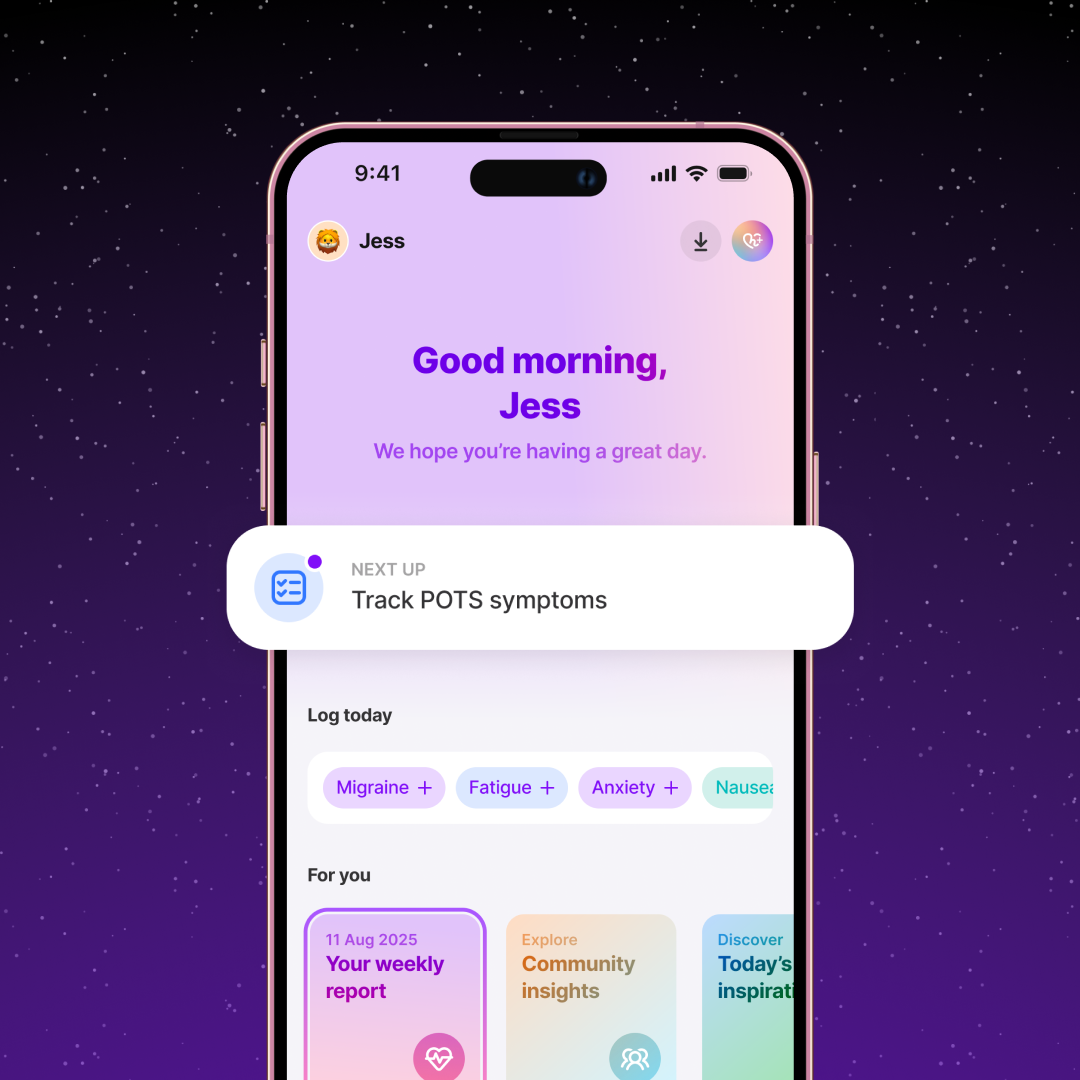POTS And Blood Pressure: Does POTS Affect Blood Pressure?
November 25, 2025

- POTS is identified by a sustained increase in heart rate when standing, while blood pressure can fall, remain steady, or rise.
- These differences reflect how the body’s built-in control of circulation doesn’t work the same way for everyone with POTS.
- Symptoms such as light-headedness, palpitations, blurred vision, and fatigue often accompany these changes in blood pressure.
- Regularly tracking both heart rate and blood pressure helps patients and clinicians identify patterns and manage symptoms.
Disclaimer: This article is for general informational purposes only and does not constitute medical advice. Always consult a qualified healthcare professional before making decisions about diagnosis or treatment.
Living with postural orthostatic tachycardia syndrome (POTS) can make everyday activities challenging, especially when something as simple as standing suddenly changes how your blood pressure behaves.
POTS is defined by a sharp increase in heart rate when upright, and blood pressure may rise, fall, or stay the same depending on how the body compensates.
In this article, you’ll learn how and why these fluctuations happen, what symptoms may appear, and simple ways to track changes and share them with your healthcare professional.
How are POTS and blood pressure related?
POTS is defined by a marked rise in heart rate when standing, yet blood pressure may increase, fall, or remain stable. Some forms of POTS are linked with low blood pressure from reduced blood volume, while others show higher readings caused by increased nerve signals that raise blood pressure.
Together, these findings highlight how complex blood pressure control can become when autonomic function is disrupted. Such variability helps explain why heart rate and blood pressure responses do not always change together in people with POTS.
Common patterns of blood pressure changes and POTS
Blood pressure responses in POTS are not uniform, and may be lower, unchanged, or higher when a person stands. These differences reflect how the autonomic nervous system regulates circulation and may change during a typical POTS episode.
Some people with POTS have reduced blood volume, a feature observed in several studies.
In some cases, blood pressure remains steady even as the heart rate rises sharply on standing.
A smaller group experiences higher readings while upright. This pattern is sometimes called the hyperadrenergic form of POTS.
Understanding these patterns helps explain why two people with POTS can have different blood pressure responses.

Why does blood pressure fluctuate in POTS?
In POTS, the heart rate speeds up when you stand, but blood pressure doesn’t always act the same. This happens because different body systems handle blood flow in different ways. Factors like nerve control, blood volume, and hormones all play a part. Understanding these patterns can help explain why people with POTS can feel light-headed one day and stable the next.
Hyperadrenergic response
In some people, standing triggers what’s called a hyperadrenergic response. This simply means the body releases more norepinephrine than usual to keep blood flow steady. Norepinephrine is a chemical that tightens blood vessels, so when there’s extra, the vessels narrow more than they typically would. This can lead to a rise in blood pressure when standing. The stronger the norepinephrine release, the more the blood pressure may increase.
Pooling in the legs
For some people with POTS, the nerves in their legs don’t control the blood vessels properly, which can cause blood to pool in the leg veins. This means less blood returns to the heart, which can make blood pressure fall for a short period of time.
Low blood volume
Many people with POTS have less total blood volume than the general population. With less blood to pump, the body has to work harder to keep blood pressure steady.
See how POTS may also affect blood sugar balance.
Daily and testing differences
Blood-pressure readings can shift based on the time of day and the type of test used. Research shows that standing tests and tilt-table tests can produce different patterns because each one challenges the circulatory system in a slightly different way. Studies also suggest that orthostatic responses (like changes in heart rate or blood pressure when you stand) tend to be stronger in the morning due to normal overnight changes in the body.
Blood pressure changes in POTS come from several overlapping causes. Individual nervous system control, blood volume, and hormones all play a role, so no two people show the exact same pattern.
Symptoms that may accompany blood pressure changes
In POTS, changes in blood pressure and heart rate while standing are linked to a consistent cluster of symptoms. Tracking them can help show patterns that your clinician can use for diagnosis and treatment.
Light-headedness and dizziness
Standing can trigger light-headedness or a spinning/floating sensation. These orthostatic symptoms are what doctors look for, and they usually ease when you lie down. Recording the time of day and position you’re in when you feel symptoms alongside your blood pressure reading adds useful context for clinicians.
Rapid heartbeat and palpitations
A fast or pounding heartbeat while standing is typical in POTS. This happens as the body works to maintain circulation when standing or changing position affects blood flow.
Visual changes
Blurred or tunneled vision can occur as blood flow to the eyes and brain briefly changes during standing.
Fatigue and weakness
Fluctuating blood pressure and repeated stress may lead to feelings of tiredness or physical weakness. This is part of the broader fatigue pattern common in people with POTS.
Brain fog and poor focus
Some people report reduced concentration or mental clarity when standing, sometimes called “brain fog.”
Recognizing these symptoms helps you and your clinician understand how changing positions from sitting to standing affects blood flow and pressure. Logging them regularly in the Human Health app can turn those patterns into clearer insights that guide care and next steps.
{{inline-cta-1}}
How to manage blood pressure fluctuations in POTS
There isn’t one single approach that works for everyone with POTS. Management focuses on easing symptoms and stabilizing circulation. Most strategies combine lifestyle adjustments, careful fluid and salt intake, and medical review. Tracking how your body responds over time helps guide what works best for you.
Step 1: Support blood volume
Studies show that drinking adequate fluids and increasing sodium in your diet, when advised by a clinician, can help maintain blood pressure stability.

Step 2: Reduce blood pooling
Compression garments that cover the abdomen and legs help return blood to the heart during standing. Simple actions like gently tensing your leg muscles or crossing your legs can help reduce light-headedness caused by blood pooling.
Step 3: Review medications regularly
Certain drugs, including diuretics and vasodilators, may lower blood pressure or increase heart rate. Regular review with a healthcare provider helps ensure that treatments taken for other conditions do not worsen POTS symptoms.
Step 4: Rebuild tolerance through movement
Exercise programs that begin with seated or reclined activity (such as rowing, cycling, or swimming) have been shown to improve circulation and reduce an increased heart rate when standing over time. Gradual, supervised progression supports long-term conditioning.
The Human Health app allows users to record heart rate and blood pressure as they are taken. Consistent tracking helps clinicians see how changes in daily life or different treatments affect progress.
Managing POTS takes patience and guidance. Hydration, compression, tailored exercise, and medication review all play roles, but the right combination differs for each person and should always be supervised, especially during a POTS flare-up.
Explore more about natural remedies that may help manage POTS symptoms.
When should you see a doctor?
If blood pressure changes or dizziness start interfering with daily life, it’s time to seek medical review. A clinician can check for underlying causes, confirm whether the symptoms fit POTS, and tailor a management plan.
Sudden fainting, chest pain, or breathlessness should always be checked out by your doctor as soon as possible. Early assessment helps prevent worsening symptoms and offers reassurance through proper diagnosis and monitoring.
Manage your condition easily with the Human Health app
Living with POTS can be unpredictable, but tracking your symptoms helps you understand how your body responds to changes in posture, stress, or activity. The Human Health app keeps your readings, heart rate, and notes together in one secure place. Over time, you and your clinician can review the patterns that appear and adjust your care plan. Consistent tracking turns uncertainty into insight and gives you more control over daily well-being.
References
- Raj SR. Postural Tachycardia Syndrome (POTS). Circulation. 2013;127(23):2336–2342. doi:https://doi.org/10.1161/circulationaha.112.144501
- Benarroch EE. Postural Tachycardia Syndrome: A Heterogeneous and Multifactorial Disorder. Mayo Clinic Proceedings. 2012;87(12):1214–1225. doi:https://doi.org/10.1016/j.mayocp.2012.08.013
- Arnold AC, Ng J, Raj SR. Postural tachycardia syndrome – Diagnosis, physiology, and prognosis. Autonomic Neuroscience. 2018;215:3–11. doi:https://doi.org/10.1016/j.autneu.2018.02.005
Disclaimer: This article is for general informational purposes only and does not constitute medical advice. Always consult a qualified healthcare professional before making decisions about diagnosis or treatment.
This is a div block with a Webflow interaction that will be triggered when the heading is in the view.


Stay on top of your POTS management using the Human Health app
Use daily tracking to see how stress, meals, and posture changes affect your blood pressure and overall POTS symptoms.








.jpg)




.png)

